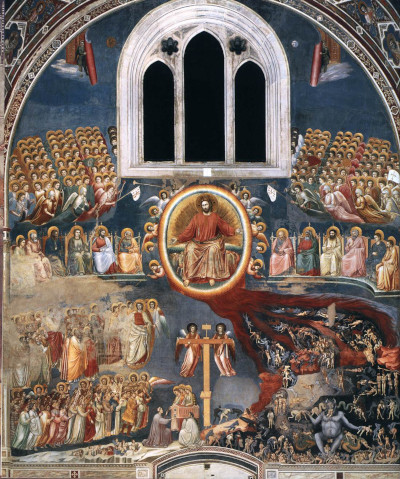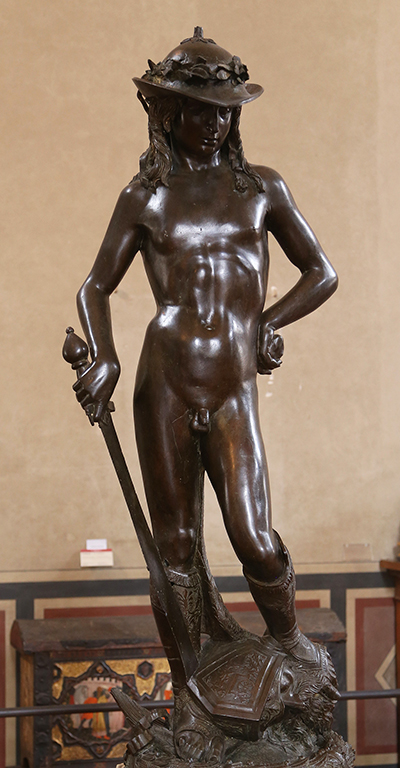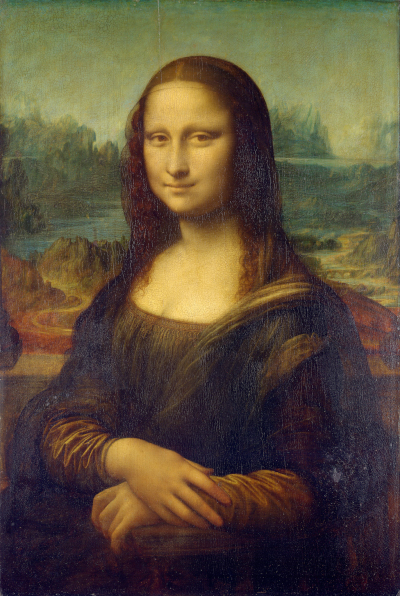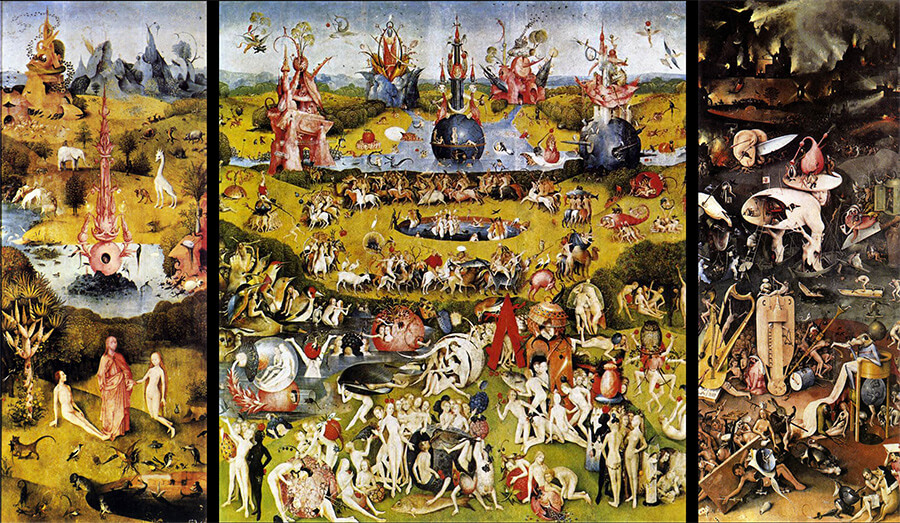Raising of Lazarus is a painting that depicts the biblical narration of the raising of Lazarus. Although the main feature of this painting follows the Byzantine iconography traditions, Giotto tends to concentrate on bringing out the dramatic nature of the happenings.
The scene displayed here was just one of a large number of frecoes produced by the artist for the Scrovegni Chapel in Padua, Italy in the very early 14th century. One section of the project would concentrate on the life of Christ, with around two dozen artworks capturing various episodes from the Bible. He would do similar with Mary too, before finishing off the interior with several more designs to fit the unique architecture. The cycle itself is regarded as his finest achievement, and within that, The Raising of Lazarus is considered one of the specific highlights. Certain stylistic touches run throughout the entire series and despite employing a large number of assistants for many of the tasks in this considerable commission, Giotto himself was still able to keep a clear style which persisted throughout the cycle of frescoes. The story of Lazarus provided an opportunity for him to display a dramatic moment from the Bible, where one of Jesus's followers is resurrected from the dead. The passage itself tells us of the importance of faith in God, and the rewards that this can bring for those who commit themselves to his word.
Giotto brought about changes within Italian art, starring as he did within the Proto-Renaissance. Many traditional approaches to art found within the medieval period would be moved on from, with this artist being at the forefront of the transition. His perspectives were not so flat, and his colours far brighter. The faces of his portraits would carry more emotion and his figures also more closely matched what we would see in real life. He also made use of stunning gold paint but this was not prevalent within the Scrovegni Chapel, where tones of blue dominated throughout both his series on Mary and Christ. Some of the themes covered within this cycle of frescoes would then be re-visited later on in his career, allowing us to see how he would tweak his ideas over time. Many of these follow-up pieces made use of relatively similar compositions, suggesting that he was satisfied with the way in which the chapel interior was decorated in the early 14th century. It also allowed him new commissions, with news of this display spreading across Italy.
It would become fairly common later in the Renaissance to produce series of works related to the life of Christ. Raising of Lazarus would appear regularly within these bodies of work, and has become a well known element of Christian art. Typically, artists will be attracted to any themes that offer emotion, where they can really create an impact within the painting or sculpture, and the Bible actually hosts a large number of passages that could be used in this way. Indeed, the likes of Giotto would already have come across examples of where artists from previous centuries had covered Christian content, and would then take elements of those depictions and add some of their own innovations on top. This passage would then continue onwards for centuries to come, though in recent years there has been a reduced impact of religion within western art, in part because of how society has become interested in other interests. Despite that, many in the present day still love to refer back to the great Renaissance paintings, such as Raising of Lazarus by Giotto di Bondone from 1303-1305.
Table of Contents
- Description
- The Story of the Raising of Lazarus
- Bible Verse
- Meaning
- Where can Giotto's Painting be Found Today?
- How Many Times did Giotto Paint The Raising of Lazarus?
- Which other Artists covered this Theme?
- The History of the Scrovegni Chapel
- Related Artworks found alongside the Painting
- Large Image of Giotto's Raising of Lazarus
Description
With precision, he is able to bring out the shocked admiration of those present, their amazement, annoyance and panic with which they observed the miracle. The artist is able to bring out dramatic scenes by placing Jesus and Lazarus at the opposite ends of the painting, with Jesus radiating divine power while Lazarus appears in a grey doll from the world of the dead. The artist also captures movements and faces made by a boy and an old man standing between Jesus and Lazarus. Each of the attributes captured ensure that it is clear that not only are the two opposite each other physically but also in terms of their feelings. The young boy is dressed in pale green clothes and gazes directly into the face of Lazarus, with a face conveying great amazement while his hand is stretched to Jesus as if locating the direction in which a life-giving force came from.
On the other hand, the old man dressed in a yellow cloak and standing next to Lazarus, is portrayed abruptly in profile, staring at Jesus with an utmost inquisitive look. However, his hands are untying the burial veil of Lazarus.On the right side of this painting are two men who are standing behind the risen, covering their faces as if keeping off the stench of the body that began to decay. Before them, are two young men laying the ground stone slab that covered the entrance to the cave-tomb. In the forefront, Mary and Martha are kneeling while stretched out to Jesus. Their figures represent the prehistory of the miracle and the composition scheme and the closure link that is made between Jesus and their brother-Lazarus. Moreover, their kneeling act embodies and communicates their acceptance of Jesus as the saviour and son of God.
Through their eyes and stance, Mary and Martha express a wide array of emotions. On their faces, for instance, there is an indication of intense grief as well as concern. These are dotted with the glow of amazing gratitude; like that of a mother who believed her child was in danger only to realize that the child is secure and protected. Behind Jesus stands the apostles, with the foreground featuring the figures of Peter and John shocked at the sight of the resurrected Lazarus. All the characters in this painting are portrayed as heroes in the raising of Lazarus. In fact, the coming together brings out an emotional richness unknown before in the visual arts. It also portrays vivid tension enhanced by colours and forms. Through this painting, the artist was able to express the reaction of people when supreme beings reveal their powers to them.
The Story of the Raising of Lazarus
The story, featured in the Gospel of John, explains the death of Lazarus and the aftermath of this tragedy, before later Christ returns to the tomb of Lazarus and helps to resurrect him. Our subsequent knowledge about this event places us in Bethany, which is today a town in the West Bank. It would be four days in which Lazarus lied in his tomb before the resurrection occurred, and it would become known as one of Christ's many miracles which litter the Old and New Testament. Eleazer (Lazarus) was a follower of Jesus and lived in Bethany, near Jerusalem. He is also brother to Mary and Martha who also appear within the Bible. He becomes ill and his sisters contact Jesus in fear for their brother's condition. He tells them not to worry, and eventually visits once Lazarus has already passed away. Martha and Mary doubt Jesus now, but eventually re-affirm their commitment to his word, and shortly afterwards Christ rewards them by resurrecting their brother, Lazarus.
Bible Verse
The story itself is mentioned in the Gospel of John (John 11:1–44), within the New Testament. The overall passage tells us first about the death of Lazarus, and then the comforting of his grieving sisters by Christ. The final section, detailed below, then explains the event in which Jesus visits the tomb and speaks to God for assistance. Shortly afterwards, Lazarus then appears from his grave, alive once more.
Jesus, once more deeply moved, came to the tomb. It was a cave with a stone laid across the entrance. "Take away the stone," he said.
"But, Lord," said Martha, the sister of the dead man, "by this time there is a bad odor, for he has been there four days."
Then Jesus said, "Did I not tell you that if you believe, you will see the glory of God?"
So they took away the stone. Then Jesus looked up and said, "Father, I thank you that you have heard me.
I knew that you always hear me, but I said this for the benefit of the people standing here, that they may believe that you sent me."
When he had said this, Jesus called in a loud voice, "Lazarus, come out!"
The dead man came out, his hands and feet wrapped with strips of linen, and a cloth around his face.
Jesus said to them, "Take off the grave clothes and let him go."
Meaning
Christ displays the power of God to his believers, as promised. He urges them to follow him and the word of God, and in return, Lazarus is resurrected. There are several meanings to be found within this story, but perhaps the strongest is in teaching the importance of faith and belief, and what can be experienced for those who hold these beliefs the most strongly. The story also provides a further examples of Christ's ability to deliver miracles, which helps to build his status within the overall narrative. He speaks directly to God, and shows confidence that he will be heard. This miracle shows evidence of his own powers, and of the influence of God in allowing Lazarus to return to life in return for the commitment of those around Christ. To achieve the impossible underlines how normal people cannot understand the power of divine figures but can bring it to their benefit if they follow the right path. This story therefore helps to strengthen their resolve and commitment to God, helping them to avoid veering down the wrong path when their faith might be challenged or weakened.
Where can Giotto's Painting be Found Today?
This depiction of The Raising of Lazarus can be found in the Scrovegni Chapel in Padua, Italy. It sits in the middle tier of the north wall. The item can be found in the same row of The Finding in the Temple (Jesus among the doctors), The Baptism of Jesus, The Wedding at Cana, Christ enters Jerusalem and Casting out the money changers. You may notice that some refer to the piece displayed on this page by the alternative name of The Resurrection of Lazarus, but essentially the two titles refer to the same passage of the Bible. Having been translated into so many languages, and discussed within different cultures over centuries, it is perhaps inevitable that different names for the same passages of scripture might appear. Those interested in seeing these paintings in person should head to the chapel, where the frescoes remain today in the Italian city of Padua. Tourists are welcome here, but efforts are made to avoid to many people entering this small building at any one time in order to preserve both the frescoes themselves, but also the architecture which is of considerable artistic value itself.
How Many Times did Giotto Paint The Raising of Lazarus?
We know of two depictions of the Raising of Lazarus by Giotto di Bondone. The first, as shown and discussed here, was produced for the interior of the Scrovegni Chapel in Padua over the period of 1303-1305. The slightly lesser known version was added to the Magdalen Chapel, Lower Church, San Francesco, Assisi in the 1320s, up to two decades after his earlier version. It must be pointed out, however, that the attribution of the latter is still up for discussion, and some are not sure whether it was truly from the hand of Giotto himself. Indeed, many of the artworks in Assisi suffer a similar status, mainly due to the fact that a good number of different artists are known to have worked here during the 14th century and that some would mimic the style of Giotto for their own success. That said, these two versions are noticeably similar in style, with just an alteration in how the figures are composed and organised, but if it was not Giotto's work, then it was clearly someone copying his style. It is hard to imagine this particular debate every being entirely resolved now, with so many centuries having passed since then and most potential avenues of research already exhausted.
Which other Artists covered this Theme?
As with all of the major themes to be found within the Bible, both the Old Testament and the New Testament, many other artists have also taken The Raising or Resurrection of Lazarus into their own oeuvres. It would be impossible to mention all of them here, but some of the notable highlights over the past few centuries have included The Raising of Lazarus by Sebastiano del Piombo, another version by Duccio in around 1310–11, plus also versions from Caravaggio in circa 1609 and Rembrandt in 1630–1631. The majority of this body of work has appeared within Italy and Northern Europe, where many of the finest artists have remained, and also Christianity was a major influence within their respective societies. Each artist would have studied previous iterations from other major names in order to make use of certain iconography, before appending their own innovations on top. Thus, the likes of Giotto could influence how later artists covered the same subject through their own interpretations, with Giotto himself being noted for his originality in terms of colour, perspective and also the style of his figurative work.
The History of the Scrovegni Chapel
The chapel was designed as a private place of worship for the Scrovegni family, with a mansion built close by. Enrico Scrovegni, the patron of this project, called upon the services of Giotto to decorate the chapel's interior. The land was purchased in the very early 14th century and, incredibly, the architecture and paintings was completed by 1305. Finance was found in order to support Giotto with a team of assistants, and they would actually complete many elements of the paintings, under his close supervision. Over time the building would eventually be opened to the public and it remains a popular tourist attraction today. The site is recognised as a location of cultural significance and efforts have been made to preserve and protect the original frescoes, keeping them within their original locations. It is hard to imagine that any of those involved in the original project could have imagined that the chapel would have remained for so many centuries, but that is testament to the quality of the art within it, and the obvious need to protect this major achievement for generations to come. The chapel remains a popular destination for international tourists heading to or from Venice.
Related Artworks found alongside the Painting
Giotto completed around two dozen paintings based on the life of Christ and also did similar with regards Mary as well. These items would then be placed in rows across the north and south walls of the chapel, before adding some custom designs for other sections of the interior. It would be hard to choose some of these frescoes over the rest, because of the similarity in style and content, and most historians will tend to refer to the cycle as a whole rather than examining its individual components. That said, other frescoes here which tend to receive the most attention include Lamentation, Crucifixion, Nativity and also Adoration of the Magi. These particular pieces combine some of his stylistic strengths, with a bold use of bright colour, expressive, natural portraits and an accurate use of figurative art. This combined with his more dynamic use of perspective, and it is easy to understand why Giotto is held in such high regard, with his legacy helping to move European art onwards from the techniques found within the medieval period.
Large Image of Giotto's Raising of Lazarus
See below for a larger image of the original fresco by Giotto. It is not easy to see this artwork up close, because of how the Chapel interior places the designs above one's eye line. They are also only around two metres in width and height, which from a distance is not big enough to spot much detail. Thankfully, the larger picture below will allow you to pick out specific parts of the scene, such as the individual figures themselves, the touches of drapery which hang from their bodies and also the other elements in the scene such as the tomb stone being lifted away and the trees and rocky landscape in the background. The colours are also bright and uplifting despite the centuries that have passed since Giotto completed his work on this sizeable commission. He retained a consistency across the Life of Christ, re-using similar tones of colour and artistic techniques, despite using a team of assistants for much of the work.

More Renaissance Artists



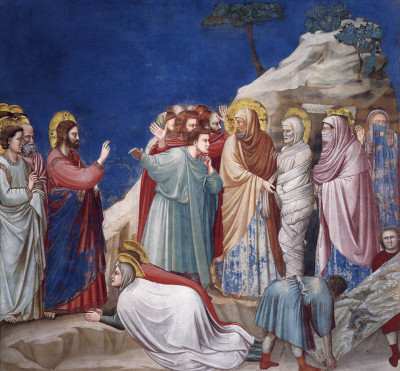
 Giotto.jpg)
 Giotto.jpg)



